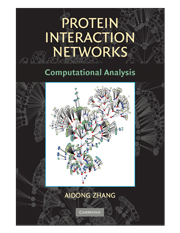Book contents
- Frontmatter
- Contents
- Preface
- 1 Introduction
- 2 Experimental Approaches to Generation of PPI Data
- 3 Computational Methods for the Prediction of PPIs
- 4 Basic Properties and Measurements of Protein Interaction Networks
- 5 Modularity Analysis of Protein Interaction Networks
- 6 Topological Analysis of Protein Interaction Networks
- 7 Distance-Based Modularity Analysis
- 8 Graph-Theoretic Approaches to Modularity Analysis
- 9 Flow-Based Analysis of Protein Interaction Networks
- 10 Statistics and Machine Learning Based Analysis of Protein Interaction Networks
- 11 Integration of GO into the Analysis of Protein Interaction Networks
- 12 Data Fusion in the Analysis of Protein Interaction Networks
- 13 Conclusion
- Bibliography
- Index
12 - Data Fusion in the Analysis of Protein Interaction Networks
Published online by Cambridge University Press: 28 January 2010
- Frontmatter
- Contents
- Preface
- 1 Introduction
- 2 Experimental Approaches to Generation of PPI Data
- 3 Computational Methods for the Prediction of PPIs
- 4 Basic Properties and Measurements of Protein Interaction Networks
- 5 Modularity Analysis of Protein Interaction Networks
- 6 Topological Analysis of Protein Interaction Networks
- 7 Distance-Based Modularity Analysis
- 8 Graph-Theoretic Approaches to Modularity Analysis
- 9 Flow-Based Analysis of Protein Interaction Networks
- 10 Statistics and Machine Learning Based Analysis of Protein Interaction Networks
- 11 Integration of GO into the Analysis of Protein Interaction Networks
- 12 Data Fusion in the Analysis of Protein Interaction Networks
- 13 Conclusion
- Bibliography
- Index
Summary
INTRODUCTION
Computational approaches such as those described in Chapters 6 through 10 analyze protein-protein interaction (PPI) networks on the basis of network properties only, with little integration of information from outside sources. Current conventional methods can predict only whether two proteins share a specific function but not the universe of functions that they share. Their effectiveness is hampered by their inability to take into consideration the full range of available information about protein functions. The discussion in Chapter 11 has demonstrated the effectiveness of integrating Gene Ontology (GO) annotations into such analysis. It has become increasingly apparent that the fusion of multiple strands of biological data regarding each gene or protein will produce a more comprehensive picture of the relations among the components of a genome [191], including proteins, and a more specific representation of each protein. The sophisticated data set, graph, or tree generated through these means can be subjected to advanced computational analysis by methods such as machine learning algorithms. Such approaches have become increasingly widespread and are expected to improve the accuracy of protein function prediction.
In this chapter, we present some of the more recent approaches that have been developed for incorporating diverse biological information into the explorative analysis of PPI networks.
INTEGRATION OF GENE EXPRESSION WITH PPI NETWORKS
Current research efforts have resulted in the generation of large quantities of data related to the functional properties of genomes; specifically, gene expression and protein interaction data. Gene expression profiles provide a snapshot of the simultaneous activity of all the genes in a genome under a given condition, thus eliminating the need to examine each gene separately.
- Type
- Chapter
- Information
- Protein Interaction NetworksComputational Analysis, pp. 243 - 250Publisher: Cambridge University PressPrint publication year: 2009
- 1
- Cited by



